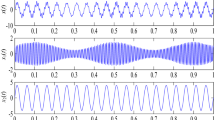Abstract
The masking signal technique provides a way to improve the empirical mode decomposition (EMD) method, which can decompose signals adaptively. In this paper, dyadic masking signals whose frequency is only determined by the first masking signal are first designed. Then, the algorithm of EMD improved by dyadic masking signals termed as EMD–DMS is proposed. The experimental results obtained by using white Gaussian noise and real-world signals are presented to demonstrate the effectiveness of the EMD–DMS algorithm.






Similar content being viewed by others
References
Huang, N.E., Shen, Z., Long, S.R., et al.: The empirical mode decomposition and Hilbert spectrum for nonlinear and non-stationary time series analysis. Proc. R. Soc. Lond. A 454, 903–995 (1998)
Yan, R.Q., Gao, R.X.: Hilbert–Huang transform-based vibration signal analysis for machine health monitoring. IEEE Trans. Instrum. Meas. 55(6), 2320–2329 (2006)
Boudraa, A.O., Cexus, J.C.: EMD-based signal filtering. IEEE Trans. Instrum. Meas. 56(6), 2196–2202 (2007)
Senroy, N., Suryanarayanan, S.: Two techniques to enhance empirical mode decomposition for power quality applications. In: IEEE Power Engineering Society General Meeting, pp. 1–6 (2007)
Senroy, N., Suryanarayanan, S., Ribeiro, P.F.: An improved Hilbert–Huang method for analysis of time-varying waveforms in power quality. IEEE Trans. Power Syst. 22(4), 1843–1850 (2007)
Laila, D.S., Messina, A.R., Pal, B.C.: A refined Hilbert–Huang transform with applications to interarea oscillation monitoring. IEEE Trans. Power Syst. 24(2), 610–620 (2009)
Deering, R., Kaiser, J.F.: The use of a masking signal to improve empirical mode decomposition. In: Proceedings IEEE International Conference Acoustics, Speech, and Signal Processing, pp. 485–488 (2005)
Flandrin, P., Rilling, G., Goncalvés, P.: Empirical mode decomposition as a filter bank. IEEE Signal Process. Lett. 11(2), 112–114 (2004)
Wu, Z.H., Huang, N.E.: A study of the characteristics of white noise using the empirical mode decomposition method. Proc. R. Soc. Lond. A 460, 1597–1611 (2004)
Yang, Y.L., Deng, J.H.: Empirical mode decomposition as a tree-structured filter: a tutorial view. In: Proceedings of the International Conference on Biomedical Engineering and Computer Science, pp. 314–317 (2010)
Yang, Y.L., Deng, J.H., Wu, C.P.: Analysis of mode mixing phenomenon in the empirical mode decomposition method. In: Proceedings of the 2nd International Symposium on Information Science and Engineering, pp. 553–556 (2009)
Yang, Y.L., Deng, J.H., Tang, W.C., et al.: Nonuniform extrema resampling and empirical mode decomposition. Chin. J. Electron. 18(4), 759–762 (2009)
Yang, Y.L., Miao, C.Y., Deng, J.H.: An analytical expression of empirical mode decomposition based on B-spline interpolation. In: Circuits, Systems & Signal Processing (2013). doi:10.1007/s00034-013-9592-5
Jerri, A.J.: The Shannon sampling theorem—its various extensions and applications: a tutorial review. Proc. IEEE 65(11), 1565–1596 (1977)
Unser, M.: Sampling—50 years after Shannon. Proc. IEEE 88(4), 569–587 (2000)
Yang, Y.L., Miao, C.Y., Deng, J.H.: Research on the mechanism of masking signals technique to improve empirical mode decomposition. J. Inf. Comput. Sci. 9(12), 3509–3516 (2012)
Acknowledgments
This research is partially supported by the key technologies R & D program of Tianjin, China, No. 13ZCZDGX01000, Natural Science Foundation of Tianjin, China, No. 12JCZDJC27800, and Natural Science Foundation for Youth of Tianjin, China, No. 13JCQNJC00900. The authors would like to thank Prof. Ran Tao for helpful discussions. The authors also acknowledge the anonymous reviewers for their helpful comments on the manuscript.
Author information
Authors and Affiliations
Corresponding author
Rights and permissions
About this article
Cite this article
Yang, Y., Deng, J. & Kang, D. An improved empirical mode decomposition by using dyadic masking signals. SIViP 9, 1259–1263 (2015). https://doi.org/10.1007/s11760-013-0566-7
Received:
Revised:
Accepted:
Published:
Issue Date:
DOI: https://doi.org/10.1007/s11760-013-0566-7




